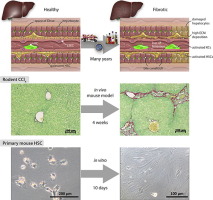Advanced Drug Delivery Reviews ( IF 16.1 ) Pub Date : 2017-07-08 , DOI: 10.1016/j.addr.2017.07.004 Leo A. van Grunsven

|
Animal testing is still the most popular preclinical assessment model for liver fibrosis. To develop efficient anti-fibrotic therapies, robust and representative in vitro models are urgently needed. The most widely used in vitro fibrosis model is the culture-induced activation of primary rodent hepatic stellate cells. While these cultures have contributed greatly to the current understanding of hepatic stellate cell activation, they seem to be inadequate to cover the complexity of this regenerative response. This review summarizes recent progress towards the development of 3D culture models of liver fibrosis. Thus far, only a few hepatic culture systems have successfully implemented hepatic stellate cells (or other non-parenchymal cells) into hepatocyte cultures. Recent advances in bioprinting, spheroid- and precision-cut liver slice cultures and the use of microfluidic bioreactors will surely lead to valid 3D in vitro models of liver fibrosis in the near future.
中文翻译:

肝纤维化的3D体外模型
动物测试仍然是最流行的肝纤维化临床前评估模型。为了开发有效的抗纤维化疗法,迫切需要鲁棒且有代表性的体外模型。最广泛使用的体外纤维化模型是培养诱导的啮齿动物原代肝星状细胞的活化。尽管这些培养物为当前对肝星状细胞激活的理解做出了巨大贡献,但它们似乎不足以涵盖这种再生反应的复杂性。这篇综述总结了肝纤维化3D培养模型开发的最新进展。迄今为止,仅少数肝培养系统已成功地将肝星状细胞(或其他非实质细胞)实施到肝细胞培养中。生物打印的最新进展,


























 京公网安备 11010802027423号
京公网安备 11010802027423号